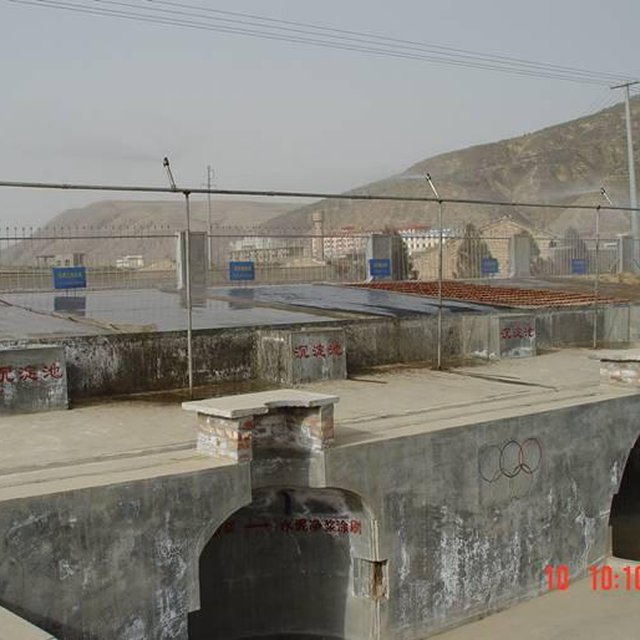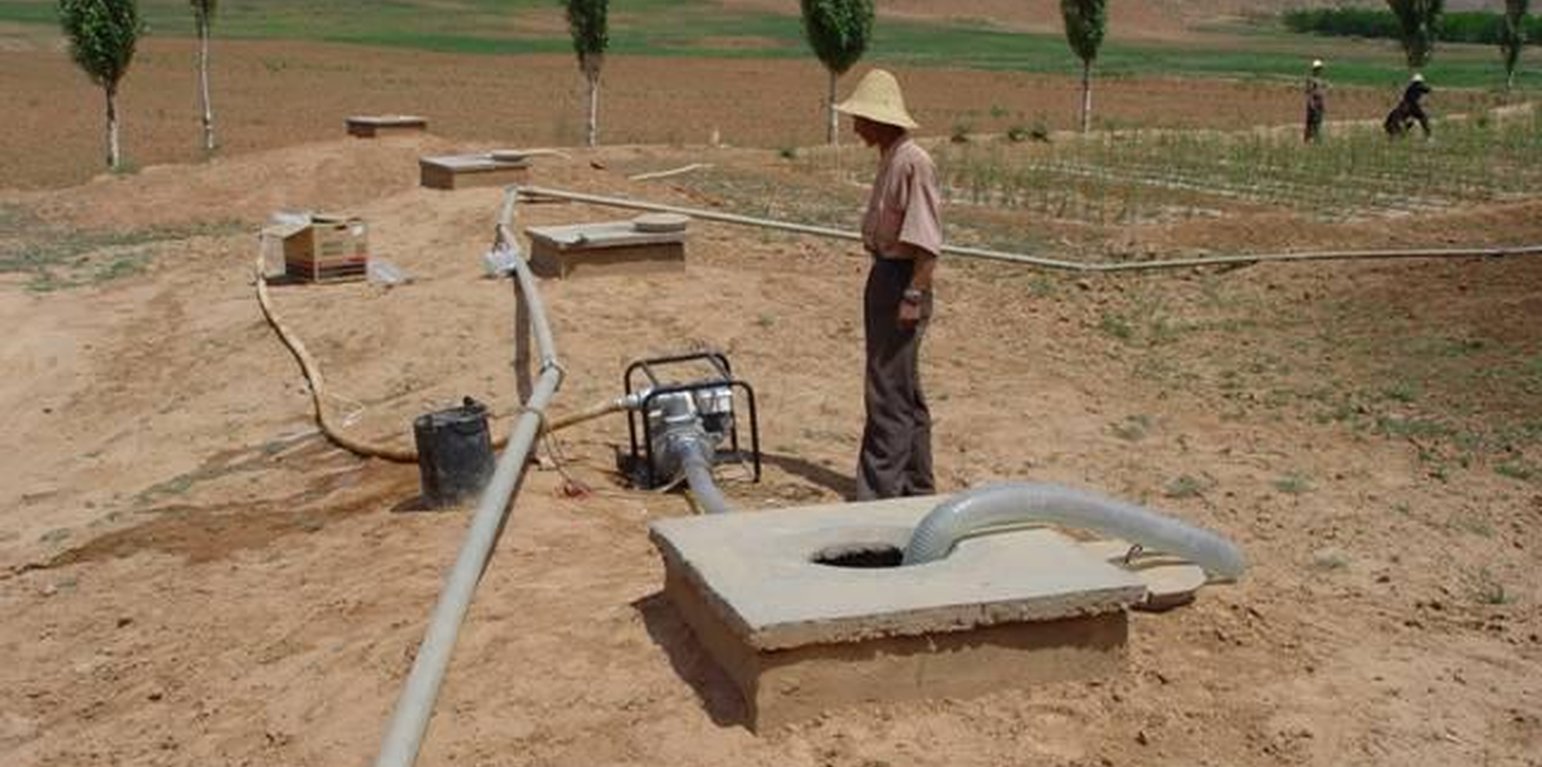Rainwater Cellars introduced through government support
(China)
Description
Government takes the lead and propelled by project, the rainwater collection for irrigation technology scales up by demonstration.
Dingxi County of Gansu Province is short of water resource. There is an old saying it's hard to exchange a cup of water for a cup of oil in Anding of Dingxi. During drought years, drinking water became a crisis and people had to walk dozens of miles to get water. With no self-relief capacity the local people live a hard life. To resolve water shortage, the most realistic method is to tap into the potential of local precipitation. Under the support of the Gansu provincial government, researches on rainwater collection were conducted during the period from 1988 to 1992 and water cellar technology was proven technically and economically feasible with its functions in preventing erosion, developing arid cropland and ecosystem recovery.
In 1994, the government disseminated water cellar technology in the northwestern part of the county covering 14 townships and 4376 households. After completion, the drinking water supply problem was mitigated for 22,000 people and 8700 animals. In 1995, a severe drought hit Gansu and the provincial government immediately initiated “1-2-1 Rainwater Collection Project, under which the government supplied cement and the local people provided sand/stone and labor to build water cellars. According to this project each household should build one water catchment with an area of100m2 made by concrete cement and two water cellars and one backyard cashcrop forest. By the end of 2000, a total of 57800 households were involved in the project to provide drinking water to 60,900 people and 333,900 heads of livestock. In addition, dryland farming has seen great development. Since 1996, water cellar technology has been diversified and evolved. The water collection fields have extended from roof and courtyard to road surface, ditch, hillside, land brink, etc and the application has been widened to scale livestock farming, spot watering and conservation irrigation of farmland based on the achievement of the 1-2-1 rainwater collection project. Moreover, water cellar technology has been gradually combined with greenhouse production, tourism agriculture, etc to form a development model integrating rainwater conservation irrigation, dryland farming and improved livelihood standards.
Location
![]()
Location: Anding, Gansu, China
Geo-reference of selected sites
Initiation date: n.a.
Year of termination: n.a.
Type of Approach
-
traditional/ indigenous
-
recent local initiative/ innovative
-
project/ programme based

Rainwater catchment experiment
Approach aims and enabling environment
Main aims / objectives of the approach
Aims are to: establish a extension mechanism that promotes sustainable development and involves farmers participation; improve the farmers' knowledge about rainwater utilization; strengthen farmer participation and their confidence in overcoming difficulties; solve drinking water problem; eliminate poverty
The SLM Approach addressed the following problems: lack of effective grass-roots organization; backward economy and lack funds; farmers in lack of the knowledge of water cellar establishment and management; short of drinking water for human and domestic animals
Conditions enabling the implementation of the Technology/ ies applied under the Approach
Conditions hindering the implementation of the Technology/ ies applied under the Approach
-
Availability/ access to financial resources and services: Found shortage: Farmers cannot afford water cellar construction
Treatment through the SLM Approach: The dissemination approaches include trial operation, demonstration, training, household visit for publicity, media (TV), technical handouts and posters. The key organizer of the extension is the water resources bureau of Anding District.
-
Other: Knowledge/technology shortage: Short of knowledge of rainwater high efficiency utilization and related agricultureal technology
Treatment through the SLM Approach: Demonstration and training
Participation and roles of stakeholders involved
Stakeholders involved in the Approach and their roles
| What stakeholders / implementing bodies were involved in the Approach? |
Specify stakeholders |
Describe roles of stakeholders |
| local land users/ local communities |
|
|
| SLM specialists/ agricultural advisers |
SWC experts |
|
| national government (planners, decision-makers) |
|
|
Involvement of local land users/ local communities in the different phases of the Approach
none
passive
external support
interactive
self-mobilization
initiation/ motivation
Meetings, household visits
planning
Participate in the survey and site location arrangement
implementation
Labor input for technological implementation
monitoring/ evaluation
Observation, collaboration with the survey of the technicians
Research
Participate in the surveys
Decision-making on the selection of SLM Technology
Decisions were taken by
-
land users alone (self-initiative)
-
mainly land users, supported by SLM specialists
-
all relevant actors, as part of a participatory approach
-
mainly SLM specialists, following consultation with land users
-
SLM specialists alone
-
politicians/ leaders
-
Land users and decision makers
Decisions were made based on
-
evaluation of well-documented SLM knowledge (evidence-based decision-making)
-
research findings
-
personal experience and opinions (undocumented)
Technical support, capacity building, and knowledge management
The following activities or services have been part of the approach
-
Capacity building/ training
-
Advisory service
-
Institution strengthening (organizational development)
-
Monitoring and evaluation
-
Research
Capacity building/ training
Training was provided to the following stakeholders
-
land users
-
field staff/ advisers
Form of training
-
on-the-job
-
farmer-to-farmer
-
demonstration areas
-
public meetings
-
courses
-
publicity brochures
Subjects covered
water cellar building and management, irrigation etc.
Institution strengthening
Institutions have been strengthened / established
-
no
-
yes, a little
-
yes, moderately
-
yes, greatly
Describe institution, roles and responsibilities, members, etc.
Type of support
-
financial
-
capacity building/ training
-
equipment
-
capacity building
Further details
the technology application strengthened the capacity building of the local water resources departments. Application of the technology helped other projects related to water conservancy and poverty reduction.
Research
Research treated the following topics
-
sociology
-
economics / marketing
-
ecology
-
technology
The research is conducted by provincial level researchers on the ecological, economic, social benefits of the water cellars, mainly.
Financing and external material support
Annual budget in USD for the SLM component
-
< 2,000
-
2,000-10,000
-
10,000-100,000
-
100,000-1,000,000
-
> 1,000,000
Precise annual budget: n.a.
Approach costs were met by the following donors: government (Local founds): 15.0%; other: 85.0%
The following services or incentives have been provided to land users
-
Financial/ material support provided to land users
-
Subsidies for specific inputs
-
Credit
-
Other incentives or instruments
Financial/ material support provided to land users
Labour by land users was
-
voluntary
-
food-for-work
-
paid in cash
-
rewarded with other material support
Credit
-
Conditions: repayment conditions: credits are sometimes used, with interest rate similar with that of commercial loan.
-
Credit providers: n.a.
-
Credit receivers: n.a.
Impact analysis and concluding statements
Impacts of the Approach
No
Yes, little
Yes, moderately
Yes, greatly
Did other land users / projects adopt the Approach?
it has been adopted extensively by neighboring provinces. Chinese Women's Federation has initiated the public welfare program named 'Mothers Water Cellar' in northern China.
Main motivation of land users to implement SLM
Sustainability of Approach activities
Can the land users sustain what hat been implemented through the Approach (without external support)?
Conclusions and lessons learnt
Strengths: land user's view
Strengths: compiler’s or other key resource person’s view
-
solve the problems of aridness and drinking water for human and livestock (How to sustain/ enhance this strength: continued project support)
-
strong extension mechanism (How to sustain/ enhance this strength: further strengthen the role of technical extension organizations)
-
Improve farmer's life (How to sustain/ enhance this strength: develop dryland agriculture industry)
Weaknesses/ disadvantages/ risks: land user's viewhow to overcome
Weaknesses/ disadvantages/ risks: compiler’s or other key resource person’s viewhow to overcome
-
high investment for technology adoption
use of micro-credits, optimized use of farming technology for high benefit agriculture.
-
weak monitoring and evaluation
establish participatory monitoring and evaluation mechanism.
References
Date of documentation: Sept. 28, 2010
Last update: July 12, 2017
Resource persons
-
Anna Schuler (anna.schuler@cde.unibe.ch) - SLM specialist
-
Yaolin Wang - SLM specialist
Full description in the WOCAT database
Documentation was faciliated by
Institution
- CDE Centre for Development and Environment (CDE Centre for Development and Environment) - Switzerland
- GEF/OP12 Gansu Project (GEF/OP12 Gansu Project) - China
Project




